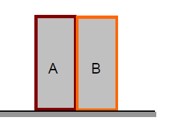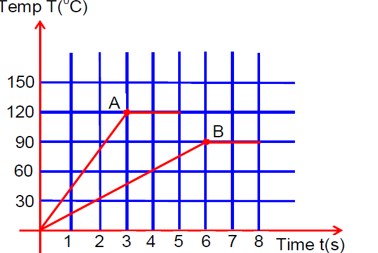Physics Thermal Properties of Matter
Get insights from 57 questions on Physics Thermal Properties of Matter, answered by students, alumni, and experts. You may also ask and answer any question you like about Physics Thermal Properties of Matter
Follow Ask QuestionQuestions
Discussions
Active Users
Followers
New answer posted
2 months agoContributor-Level 10
The decrement in length is more for metal strip-A than metal strip-B, so the combined system bend towards the left.
New answer posted
3 months agoContributor-Level 9
dQA = mACA dTA
dQB = mBCB dTB
dQA/dt = dQB/dt
⇒ mACA (dTA/dt) = mBCB (dTB/dt)
⇒ (dTA/dt)/ (dTB/dt) = (mBCB)/ (mACA)
Assuming mA = mB
(dTA/dt)/ (dTB/dt) = CB/CA
CA/CB = (dTB/dt)/ (dTA/dt) = (90/6)/ (120/3) = 15/40 = 3/8
New answer posted
3 months agoContributor-Level 10
On a heating curve, plateaus occur at the melting and boiling points because the heat energy supplied goes into latent heat (phase change) rather than raising the temperature.
New answer posted
3 months agoContributor-Level 10
Change of state refers to a substance transitioning between solid, liquid, and gas phases, during which energy is absorbed or released at constant temperature. The latent heat is the energy required for that transition without changing the temperature.
New answer posted
3 months agoContributor-Level 10
It works best for small to moderate temperature differences; large differences may require more complex heat transfer models.
New answer posted
3 months agoContributor-Level 10
It's applied in forensics for estimating time of death, in engineering for cooling rate analysis, and in food Science to predict cooling times.
New answer posted
3 months agoContributor-Level 10
The ideal gas equation fails at high pressures, low temperatures, and for gases with strong intermolecular forces or large molecular volumes.
New answer posted
3 months agoContributor-Level 10
An ideal gas is a theoretical or hypothetical gas that obeys the ideal gas law perfectly. That is, PV=nRT.
Taking an Exam? Selecting a College?
Get authentic answers from experts, students and alumni that you won't find anywhere else
Sign Up on ShikshaOn Shiksha, get access to
- 65k Colleges
- 1.2k Exams
- 679k Reviews
- 1800k Answers


